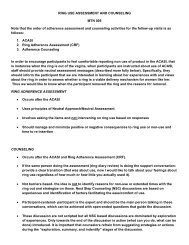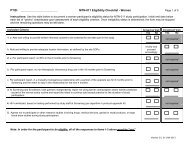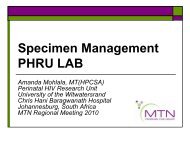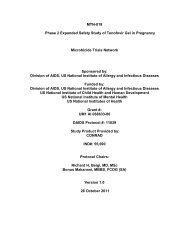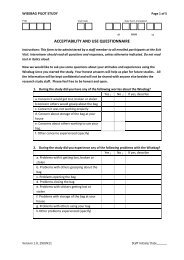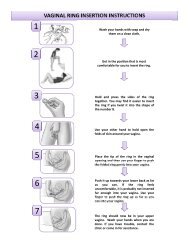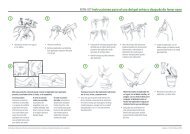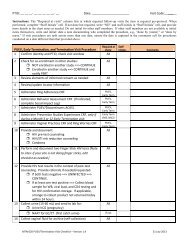Section 05: Informed Consent
Section 05: Informed Consent
Section 05: Informed Consent
You also want an ePaper? Increase the reach of your titles
YUMPU automatically turns print PDFs into web optimized ePapers that Google loves.
<strong>Section</strong> 5. <strong>Informed</strong> <strong>Consent</strong><br />
This section provides information on informed consent procedures for MTN-013/IPM 026. MTN-<br />
013/IPM 026 involves three types of informed consent:<br />
<br />
<br />
<br />
<strong>Informed</strong> <strong>Consent</strong> for Screening<br />
<strong>Informed</strong> <strong>Consent</strong> for Enrollment<br />
<strong>Informed</strong> <strong>Consent</strong> for Long-Term Specimen Storage and Possible Future Research Testing<br />
Potential study participants must provide written informed consent for screening in order to<br />
undergo protocol-specified procedures for determining eligibility for study participation. Potential<br />
participants who are found to be eligible for the study must then provide written informed consent<br />
to enroll in the study and undergo protocol-specified “on study” procedures, including random<br />
assignment, use of study product and completion of follow-up visits and procedures.<br />
For enrolled participants, informed consent for long term specimen storage and possible future<br />
research is optional. Participants may choose not to consent to long term specimen storage and<br />
possible future research testing and still be enrolled in the study. <strong>Consent</strong>ing to long term<br />
specimen storage is to be completed at the enrollment visit following the completion of the<br />
enrollment consent process.<br />
This section contains general information and instructions applicable to all three types of informed<br />
consent required for MTN-013/IPM 026. In addition, detailed guidance is provided for the<br />
standardized approach to the enrollment informed consent process that must be followed at all<br />
sites.<br />
5.1 Overview of <strong>Informed</strong> <strong>Consent</strong> Requirements and Procedures<br />
<strong>Informed</strong> consent is a process by which an individual voluntarily expresses their willingness to<br />
participate in research, after having been informed of all aspects of the research that are relevant to<br />
her decision. It is not merely a form or a signature, but a process, involving information exchange,<br />
comprehension, voluntariness, and documentation. Each of these aspects of the process is described<br />
in greater detail below. Please also refer to <strong>Section</strong> 4.8 of the International Conference on<br />
Harmonization (ICH) Consolidated Guidance for Good Clinical Practice (GCP) and the informed<br />
consent section of the DAIDS policy on Requirements for Source Documentation in DAIDS<br />
Funded and/or Sponsored Clinical Trials for further guidance on the informed consent process and<br />
documentation requirements.<br />
In MTN-013/IPM 026, informed consent is first obtained for screening procedures only. Then, for<br />
participants found to be eligible, informed consent is obtained for enrollment. Written informed<br />
consent must be obtained for all participants prior to the performance of any protocol-specified<br />
screening or enrollment procedures and assessments. For enrolled participants, informed consent is an<br />
ongoing process that continues throughout the study follow-up period.<br />
Enrolled study participants are asked to provide informed consent for long term storage of blood,<br />
vaginal and/or cervical fluid, and cervical tissue specimens for possible future research testing. The<br />
specimen storage informed consent process must take place at the enrollment visit and after the<br />
participant provides written informed consent for enrollment. Participants may choose to not have<br />
their specimens stored for possible future research testing and still remain in the study.<br />
MTN-013/IPM 026 SSP Manual Final Version 1.2 13 January 2012<br />
<strong>Section</strong> 5 Page 5-1
US regulations (45 CFR 46) specify the elements of informed consent that must be conveyed to<br />
research participants through the informed consent process. It is the responsibility of the Investigator<br />
of Record (IoR), and by delegation all study staff involved in the informed consent process, to deliver<br />
all required information to potential study participants.<br />
Based on the technical and regulatory reviews that are completed as part of the protocol development<br />
and study activation processes, there is adequate assurance that once a site has been “activated” for<br />
study implementation, the site-specific informed consent form specifies all information required by<br />
the regulations. However, responsibility for informed consent does not end with preparation of an<br />
adequate informed consent form. It also is the responsibility of the IoR and designated study staff to:<br />
<br />
<br />
<br />
<br />
Deliver all required information in a manner that is understandable to potential study<br />
participants<br />
Assure that informed consent is obtained in a setting free of coercion and undue influence<br />
Confirm that the participant comprehends the information<br />
Document the process<br />
If the participant is not able to read (literate), an impartial literate witness must be present during the<br />
entire informed consent process/discussion with the participant. As part of the documentation steps<br />
detailed below, the witness will be asked to sign and date the informed consent form to attest that the<br />
information in the consent form was accurately explained to and apparently understood by the<br />
participant and that informed consent was freely given by the participant. An “impartial” witness is<br />
defined as a person who is independent of the study (though need not be “totally unaffiliated’), who<br />
cannot be unfairly influenced by people involved with the study. Refer to <strong>Section</strong> Appendix 5-1 for a<br />
summary of considerations for obtaining informed consent from illiterate participants.<br />
When a witness is present during the informed consent process, care should be taken to minimize the<br />
perception of coercion due to the presence of the witness. The purpose of having the witness present<br />
should be clearly explained to the participant, with emphasis on the fact that the witness is there as a<br />
protection for the participant, not as an agent of the study per se.<br />
Each study site must establish an SOP for Obtaining <strong>Informed</strong> <strong>Consent</strong> from potential study<br />
participants that ensures that all of the above-listed requirements are met. The SOP must be consistent<br />
with the DAIDS policy on Requirements for Source Documentation in DAIDS Funded and/or<br />
Sponsored Clinical Trials. It is recommended that the SOP contain the elements listed below and that<br />
each site seek IRB review and approval of the SOP:<br />
<br />
<br />
<br />
<br />
<br />
<br />
<br />
<br />
<br />
<br />
<br />
Minimum legal age to provide independent informed consent for research at the study site<br />
Procedures for ascertaining participant identity and age<br />
Procedures for ascertaining participant literacy<br />
Procedures for providing all information required for informed consent to the participant<br />
Procedures for determining participant comprehension of the required information<br />
Procedures to ensure that informed consent is obtained in a setting free of coercion and undue<br />
influence<br />
Procedures for documenting the informed consent process<br />
Storage locations for blank informed consent forms<br />
Storage locations for completed informed consent forms<br />
Procedures to ensure that the many different study informed consent forms are easily<br />
distinguished and used appropriately (e.g., color-coding)<br />
Procedures for implementing a change in the version of the informed consent form used<br />
MTN-013/IPM 026 SSP Manual Final Version 1.2 13 January 2012<br />
<strong>Section</strong> 5 Page 5-2
Staff responsibilities for all of the above<br />
QC/QA procedures related to the above (if not specified elsewhere)<br />
5.2 <strong>Informed</strong> <strong>Consent</strong> for Screening<br />
At each study site, the informed consent process for screening will be conducted according to<br />
site SOPs. <strong>Informed</strong> consent for screening must be obtained prior to performing any study<br />
screening procedures. For participants who do not consent to screening, no screening<br />
procedures should be performed and no data that can be linked to the participant’s name or<br />
other personal identifier(s) should be recorded. <strong>Consent</strong> for Screening will be documented on the<br />
Enrollment DataFax CRF.<br />
5.3 <strong>Informed</strong> <strong>Consent</strong> for Enrollment<br />
At each study site, the informed consent process for enrollment will be conducted according to site<br />
SOPs. However, site SOPs must reflect the standardized approach to the enrollment informed<br />
consent process that is described in this section. <strong>Informed</strong> consent for enrollment must be obtained<br />
prior to performing any study enrollment or “on-study” procedures. An overview of the standardized<br />
approach to the enrollment informed consent process is provided in Figure 5-1. Additional details<br />
related to key steps in the process are provided in the remainder of this section. <strong>Consent</strong> for Screening<br />
will be documented on the Enrollment DataFax CRF.<br />
5.4 <strong>Informed</strong> <strong>Consent</strong> for Specimen Storage and Possible Future Research Testing<br />
At each study site, the informed consent process for specimen storage and possible future research<br />
testing will be conducted according to site SOPs for each enrolled study participant. Participants must<br />
indicate on the form whether she agrees to storage and future testing of blood specimens, storage and<br />
future testing of vaginal and/or cervical fluid specimens, and/or storage and future testing of cervical<br />
tissue any time during study participation. For participants who do not consent to specimen storage<br />
and possible future research testing, specimens collected and stored on-site per protocol will be<br />
retained until the study is completed and all protocol-specified testing has been completed.<br />
Thereafter, any remaining specimens collected from these participants will be destroyed. <strong>Consent</strong> for<br />
long-term specimen storage will be documented on the Eligibility Criteria DataFax CRF.<br />
MTN-013/IPM 026 SSP Manual Final Version 1.2 13 January 2012<br />
<strong>Section</strong> 5 Page 5-3
Figure 5-1<br />
Overview of MTN-013/IPM 026 <strong>Informed</strong> <strong>Consent</strong> Process<br />
Briefly describe the steps in the consent<br />
process and tell the participant how long it<br />
takes to complete.<br />
Does she have time to complete<br />
this today?<br />
ASK<br />
• If yes, proceed.<br />
• If no, schedule return appointment.<br />
ASK<br />
Is she ready to have the<br />
informed consent form<br />
read to her or read it herself?<br />
• If yes, proceed.<br />
• If not, determine what she needs and provide<br />
information or schedule return appointment.<br />
Read consent form, section by section,<br />
asking if she has questions and discussing as<br />
you go along.<br />
Does she feel comfortable<br />
ASK that she understands all<br />
aspects of the study?<br />
• If yes, proceed.<br />
• If not, determine what she needs and<br />
provide more information or schedule<br />
return appointment.<br />
Administer comprehension checklist (if<br />
enrollment).<br />
ASK<br />
All questions/points on<br />
the checklist.<br />
• If participant demonstrates comprehension of<br />
all required points, proceed.<br />
• If not, discuss misunderstandings and probe<br />
problem areas with open-ended questions.<br />
Provide information and review booklet, flip<br />
charts, and any other materials as needed to<br />
resolve misunderstandings. Continue<br />
discussing until comprehension of all<br />
required topics is demonstrated.<br />
• If participant is fatigued or requests more<br />
time, or if staff judge that participant needs<br />
more time, schedule return appointment and<br />
repeat steps in the process as needed.<br />
If the participant chooses to take part in the study, complete all name, signature, and date lines<br />
on the informed consent form. Offer participant a copy of the form. Document the process per<br />
DAIDS policy and site SOPs.<br />
MTN-013/IPM 026 SSP Manual Final Version 1.2 13 January 2012<br />
<strong>Section</strong> 5 Page 5-4
5.5 <strong>Informed</strong> <strong>Consent</strong> Support Materials<br />
Site-specific informed consent forms: The informed consent forms used at all sites must be reviewed<br />
and approved by MTN CORE (FHI360), study site IRBs and the DAIDS Protocol Registration Office<br />
prior to their use. After the forms are approved, each site is responsible for preparing bulk supplies of<br />
their approved forms and for only using the currently approved versions of the forms at all times<br />
during the study.<br />
Visual Aids: Use of visual aids is encouraged throughout the informed consent process to facilitate<br />
participant comprehension. Each site should determine the most appropriate visual aids for its study<br />
population and ensure that a “kit” containing each of these aids is available in each room where<br />
informed consent discussions take place. Study staff should use their best judgment of each<br />
participant’s information needs and how best to address those needs.<br />
Suggested visual aids for each site to consider using are as follows:<br />
Calendar<br />
Sample vaginal ring<br />
Blood collection tubes<br />
Urine specimen cup<br />
Vaginal and/or pelvic model<br />
Sample randomization envelopes<br />
Speculum<br />
Other randomization explanation visual aids (e.g., sack or box containing four items<br />
of different colors)<br />
Visual aids to explain placebo (e.g., sugar with and without vitamin A)<br />
When using vaginal and pelvic models, remember that participants may not be familiar with such<br />
models. Introduce the models in a sensitive manner and use information and rapport to help make the<br />
participant feel comfortable with the models. When using a vaginal model, hold the vaginal ring in<br />
the middle of the ring and insert it so that half is inserted inside and half is visible on the outside of<br />
the vagina.<br />
Regardless of use of the vaginal and pelvic models, study staff who take part in informed consent<br />
discussions should be prepared to demonstrate the various insertion positions and imitate insertion of<br />
the vaginal ring.<br />
5.5.1 Comprehension Assessment<br />
Study staff are responsible for determining whether potential participants comprehend all information<br />
required to make an informed decision about study participation before proceeding to make a final<br />
enrollment decision. Sample MTN-013/IPM 026 Enrollment <strong>Informed</strong> <strong>Consent</strong> Comprehension Tools<br />
(see <strong>Section</strong> Appendix 5-3 and 5-4) will assist staff in assessing participant comprehension and<br />
targeting follow-up educational efforts to ensure that participants understand all information required<br />
to make an informed decision about whether to enroll in the study.<br />
MTN-013/IPM 026 SSP Manual Final Version 1.2 13 January 2012<br />
<strong>Section</strong> 5 Page 5-5
The tool will be administered by the study staff member to each potential participant after she has<br />
completed the informed consent discussions and before she is asked to sign or mark the enrollment<br />
informed consent form. The tool should not be presented to participants as a “test,” but rather as a<br />
way of double-checking that study staff have fulfilled their responsibility to provide all information<br />
needed for the participant to make an informed decision about enrolling in the study. It is expected<br />
that the checklist will be administered by the same staff member who conducted the enrollment<br />
informed consent discussion with the participant; however, this is not required. If more than one staff<br />
member spent time with the potential participant during the informed consent process, the assessment<br />
should be administered by the person who spent the most time with the participant.<br />
The tool is structured around open-ended questions that correspond with the required elements of<br />
informed consent for research. Each question should be read to the potential participant, giving her<br />
time to respond to each one.<br />
For each question, the checklist specifies particular points that must eventually be included in the<br />
participant’s response. When the potential participant mentions one of the required points, study staff<br />
should check off that point. If the participant does not mention one or more of the required points,<br />
study staff should follow-up with another open-ended question to obtain a response about that point.<br />
All required points must be satisfactorily addressed by the participant, and checked off, before<br />
proceeding to the final informed consent decision and signing or marking of the enrollment informed<br />
consent form.<br />
When responding to the various questions, potential participants may report back more information<br />
than is included on the checklist. This is acceptable, as long as the required information is reported<br />
back. However, if any misinformation is reported back, study staff should explain the correct<br />
information before proceeding to another question.<br />
Once administration of the comprehension checklist discussion begins, it is possible that the<br />
participant may spontaneously mention many of the required points, without each separate question<br />
being asked. In these cases, study staff should check off the relevant points on the checklist and then<br />
ask the remaining questions, or probe about the remaining points. It doesn’t hurt to ask a question that<br />
a participant may have already answered in her response to a previous question. However, if staff is<br />
confident that a previous response was adequate, the specific question and/or point do not need to be<br />
repeated.<br />
It is expected that study staff administering the informed consent process and checklist will be<br />
knowledgeable about MTN-013/IPM 026 to make good judgments about potential participants’<br />
understanding of the required information. It is possible that a participant might repeat the correct<br />
information, yet the staff member may not be convinced that she really understands it. In these cases<br />
the staff should decide if further explanation or discussion is needed before proceeding to the final<br />
informed consent discussion and signing or marking of the informed consent form. The further<br />
explanation or discussion could take place at the same visit or at another visit may be suggested or<br />
scheduled.<br />
MTN-013/IPM 026 SSP Manual Final Version 1.2 13 January 2012<br />
<strong>Section</strong> 5 Page 5-6
Whenever additional information or explanation is needed, all the informed consent support materials<br />
may be used. Study staff should decide which materials may be most helpful to each participant.<br />
Some potential participants may be more comfortable interacting with the same study staff person<br />
throughout the informed consent process. However, another staff member may be consulted, if<br />
necessary or desired, to help explain problematic concepts and/or respond to participant questions or<br />
concerns.<br />
The comprehension checklist is considered a study source document that should be completed,<br />
handled, and retained in the participant’s study chart like any other source document. After<br />
administering the checklist, study staff should carefully review the checklist to verify that all required<br />
points have been satisfactorily addressed by the participant and that this is adequately documented on<br />
the checklist (i.e., with a check mark beside each point). Failure to document participant<br />
comprehension of all required points on the checklist will be considered an informed consent<br />
and enrollment violation. Comments may be recorded in the designated column on the checklist<br />
(and on the back of the checklist if additional space is needed); however, this is not required. After<br />
the enrollment consent process is completed, the final outcome of the process should be recorded in<br />
the bottom left corner of the checklist and the staff member who completed the checklist should<br />
ensure his/her signature is recorded in the space provided.<br />
5.5.2 Documenting the <strong>Informed</strong> <strong>Consent</strong> Process<br />
US regulations require that informed consent be documented by "the use of a written informed<br />
consent form approved by the IRB/EC and signed and dated by the subject or the subject's legally<br />
authorized representative at the time of consent."<br />
To fulfill this requirement, complete all signature and date blocks on the informed consent form in<br />
ink. Legal names should be used. Fabricated/falsified names should not be used. Initials may not be<br />
used in place of a participant’s full surname, and it is strongly recommended that initials not be used<br />
in place of a participant’s full first name. However, if a participant commonly signs her name using<br />
an initial for her first name, the initial may be used, provided this practice is acceptable per the<br />
policies of the study site institution(s).<br />
If the participant is not literate, the witness who was present during the informed consent discussion<br />
must sign and date the informed consent form to attest that the information in the consent form and<br />
any other written information was accurately explained to, and apparently understood by, the<br />
participant, and that informed consent was freely given by the participant. The participant printed<br />
name, signature, and signature date blocks on the informed consent form should be completed as<br />
follows:<br />
<br />
<br />
<br />
The study staff member who completes the informed consent process/discussion with the<br />
participant should enter the participant’s name below the “participant’s printed name” block,<br />
together with a signed and dated note documenting the name of the person who made the<br />
entry and the date of the entry.<br />
The participant should make her mark in the “participant’s signature” block.<br />
The study staff member who completes the informed consent process/discussion with the<br />
participant should enter the date upon which the participant made her mark on the informed<br />
consent form below the “participant signature date” block, together with a signed and dated<br />
note documenting the name of the person who made the entry and the date of the entry.<br />
MTN-013/IPM 026 SSP Manual Final Version 1.2 13 January 2012<br />
<strong>Section</strong> 5 Page 5-7
The DAIDS policy on Requirements for Source Documentation in DAIDS Funded and/or Sponsored<br />
Clinical Trials lists detailed requirements and suggestions for documenting the informed consent<br />
process. All requirements listed in the DAIDS SOP must be met. In order to also meet some of the<br />
suggestions listed in the DAIDS SOP, site staff may use an <strong>Informed</strong> <strong>Consent</strong> Coversheet similar to<br />
the example included in <strong>Section</strong> Appendix 5-2. Sites choosing to use a coversheet should list the<br />
coversheet as a source document in their SOPs for Source Documentation for MTN-013/IPM 026 and<br />
should use the coversheet consistently to document the informed consent processes with all<br />
participants. The sample coversheet is available as a separate electronic file on the Study<br />
Implementation Materials section of the MTN-013/IPM 026 web page.<br />
In addition to completing the documentation requirements on the informed consent form itself, each<br />
informed consent process must be documented in a signed and dated chart note. It is essential that the<br />
note and all other documentation (e.g., the informed consent form, the coversheet) document that<br />
informed consent was obtained before any study procedures were conducted. In particular, the<br />
documented date and end time of the informed consent process must precede the documented date<br />
and time of randomization. The chart note recorded to document the informed consent process<br />
should also document adherence to the requirements of the informed consent section of the DAIDS<br />
policy on Requirements for Source Documentation in DAIDS Funded and/or Sponsored Clinical<br />
Trials. If an informed consent coversheet is used, a chart note is still required, but it is not necessary<br />
to transcribe all information recorded on the coversheet into the chart note.<br />
Regulations require that participants be given a signed copy of the informed consent forms. If a<br />
participant opts not to receive a copy, document this in a chart note and offer the participant an<br />
alternate form of study contact information (e.g., a contact card or appointment card) in lieu of the<br />
full informed consent form.<br />
5.6 Re-<strong>Consent</strong>ing Process for Participants who were not previously tested for HBV and HCV<br />
In the event a participant was previously screened and/or enrolled, she must undergo a re-consenting<br />
process to continue participation in the study regardless of any previously documented written<br />
informed consent. Once Letter of Amendment #01 is approved at each site, all participants enrolled<br />
will need to be re-consented. Follow site SOPs for obtaining informed consent when documenting the<br />
informed consent process.<br />
In the event a participant was screened but not yet enrolled into the study prior to receiving IRB<br />
approval for LoA #01, the participant must be consented using the IRB approved revised Enrollment<br />
informed consent form and tested for Hepatitis B and Hepatitis C at their next visit. In the event a<br />
participant is enrolled into the study prior to receiving IRB approval for LoA #01, the participant<br />
must be re-consented to continue study participation using the IRB approved revised Enrollment<br />
informed consent form and tested for Hepatitis B and Hepatitis C at their next visit.<br />
The documentation requirements for the new written informed consent documents are the same as the<br />
requirements for participants joining the study for the first time (See <strong>Section</strong> 5.5).<br />
MTN-013/IPM 026 SSP Manual Final Version 1.2 13 January 2012<br />
<strong>Section</strong> 5 Page 5-8
<strong>Section</strong> Appendix 5-1<br />
Summary of Considerations for Obtaining <strong>Informed</strong> <strong>Consent</strong> from Illiterate Persons<br />
<br />
<br />
<br />
<br />
<br />
<br />
<br />
Each site must specify procedures for obtaining and documenting informed consent from<br />
illiterate persons in its SOP for obtaining informed consent. These procedures must be<br />
consistent with the DAIDS SOP for Source Documentation and must be followed each time<br />
informed consent is obtained. It is recommended that each site seek IRB/EC review and<br />
approval of these procedures.<br />
An impartial witness must be present during the entire informed consent discussion with an<br />
illiterate participant. The witness must sign and date the informed consent form to attest that<br />
the information in the consent form was accurately explained to, and apparently understood<br />
by, the participant, and that informed consent was freely given by the participant.<br />
The site SOP for obtaining informed consent should define who may serve as the witness to<br />
the informed consent process.<br />
Take care to minimize the perception of coercion due to the presence of the witness.<br />
The study staff member who completes the informed consent process/discussion with the<br />
participant should enter the participant’s name below the “participant’s printed name” block,<br />
together with a signed and dated note documenting the name of the person who made the<br />
entry and the date of the entry.<br />
The participant should make her mark in the “participant’s signature” block.<br />
The study staff member who completes the informed consent process/discussion with the<br />
participant should enter the date upon which the participant made her mark on the informed<br />
consent form below the “participant signature date” block, together with a signed and dated<br />
note documenting the name of the person who made the entry and the date of the entry.<br />
Refer to <strong>Section</strong> 4.8 of the ICH GCP guideline and the informed consent section of the DAIDS SOP<br />
for Source Documentation for additional information.<br />
MTN-013/IPM 026 SSP Manual Final Version 1.2 13 January 2012<br />
<strong>Section</strong> 5 Page 5-9
<strong>Section</strong> Appendix 5-2<br />
Sample <strong>Informed</strong> <strong>Consent</strong> Coversheet for MTN-013/IPM 026<br />
Participant Name (or PTID):<br />
Name of study staff person completing informed consent<br />
process/discussion (and this coversheet):<br />
Is the participant of legal age to provide independent<br />
informed consent for research?<br />
Type of informed consent process/discussion<br />
Date of informed consent process/discussion:<br />
Yes<br />
No STOP. Participant is not eligible for MTN-013/IPM 026.<br />
Screening<br />
Enrollment<br />
Start time of informed consent process/discussion:<br />
Language of informed consent process/discussion:<br />
Was the informed consent process/discussion<br />
conducted according to site SOPs for MTN-013/IPM<br />
026?<br />
Can the participant read?<br />
English<br />
Yes<br />
No Record and explain departures from site SOPs below.<br />
Yes<br />
No A literate impartial witness should be present during the entire<br />
informed consent process/discussion. Refer to site and<br />
DAIDS SOPs for specific instructions. Record name of<br />
witness here:<br />
Record relationship of witness to participant here:<br />
Version number/date of informed consent form used<br />
during informed consent process/discussion:<br />
Was all information required for the participant to make<br />
an informed decision provided in a language that was<br />
understandable to the participant?<br />
Were all participant questions answered?<br />
Did the participant comprehend all information required<br />
to make an informed decision?<br />
Was the participant given adequate time/opportunity to<br />
consider all options before making her informed<br />
decision?<br />
Did the participant accept a copy of the informed<br />
consent form?<br />
End time of informed consent process/discussion:<br />
Version Number:<br />
Yes<br />
No Explain below.<br />
Yes<br />
No Explain below.<br />
Yes<br />
No Explain below.<br />
Yes<br />
No Explain below.<br />
Date of Approved <strong>Informed</strong> <strong>Consent</strong> Form:<br />
NA (participant chose not to provide informed consent)<br />
Yes<br />
No Offer alternative form of study contact information to<br />
participant.<br />
Notes/Comments (continue on back if needed):<br />
Signature of study staff person completing informed<br />
consent process/discussion (and this coversheet):<br />
MTN-013/IPM 026 SSP Manual Final Version 1.2 13 January 2012<br />
<strong>Section</strong> 5 Page 5-10
<strong>Section</strong> Appendix 5-3<br />
Sample MTN-013/IPM 026 Enrollment <strong>Informed</strong> <strong>Consent</strong> Comprehension Tools (1 of 2)<br />
Question Answers <br />
Please describe your<br />
understanding of the purpose<br />
of this study.<br />
Please tell me about the<br />
different groups of women in<br />
the study.<br />
What do you understand that<br />
you are being asked to do in<br />
this study?<br />
What do you understand<br />
about possible risks that<br />
might happen as a result of<br />
being in the study?<br />
What will happen to you if<br />
you decide not to join the<br />
study?<br />
Testing an experimental vaginal ring (VR)<br />
Assess if the VR is safe to use<br />
Testing to see if the how the drugs in the VRs are absorbed in the body<br />
Evaluate if women like using the VRs and if they use it as instructed<br />
All women will use a VR which may or may not contain a drug<br />
Groups will be randomly assigned one of four different VRs<br />
All groups are important to the study<br />
No one knows which VRs they will receive<br />
Use the VRs for approximately 28 days without removing it (unless<br />
instructed to by a study clinician)<br />
Have pelvic and physical examinations<br />
Provide a sample of urine, blood and vaginal fluid/tissue samples<br />
(biopsies)<br />
Use an effective birth control method and agree not get pregnant while<br />
in the study<br />
Avoid engaging in receptive sexual activity (including anal, oral, and<br />
vaginal) and using tampons<br />
VR may cause bad effects i.e. may irritate the vagina (must mention at<br />
least one)<br />
Risks of study procedures (i.e. discomfort and pain from biopsies, mild<br />
bleeding)<br />
Possibly of social harms i.e. others may treat participants unfairly for<br />
being in the study<br />
Free to make her own decision about joining the study and can withdraw<br />
from the study at any time<br />
No change to her regular medical care/benefits whether she joins the<br />
study or not<br />
Information about participants is confidential, private, and locked away<br />
Only people working on the study have access to her information<br />
Counseling, medical exams and tests, clinical care, helping to find way<br />
to prevent HIV (must state at least one)<br />
Must state how to contact study staff<br />
How will the information<br />
about you be protected?<br />
What are the benefits to you<br />
of participating in this study?<br />
What should you do if you<br />
have any questions about<br />
what is happening in this<br />
study?<br />
Outcome:<br />
□ Demonstrated comprehension of all required points, decided to enroll in study<br />
□ Demonstrated comprehension of all required points, decided NOT to enroll in study<br />
□ Demonstrated comprehension of all required points, deferred enrollment decision<br />
□ Did not demonstrate comprehension of all required points, needs more time/discussion<br />
□ Unable to demonstrate comprehension of all required points, consent process discontinued<br />
□ Other (specify):________________________________________________________________<br />
Staff Signature:___________________________________ Date:________________________<br />
Comments<br />
Optional Comment Codes:<br />
a. Answered correctly on first try<br />
b. Could not answer at first but answered<br />
correctly with probing<br />
c. Answered incorrectly at first but answered<br />
correctly after discussion<br />
d. Not able to answer correctly at this time<br />
e. Other (describe)<br />
MTN-013/IPM 026 SSP Manual Final Version 1.2 13 January 2012<br />
<strong>Section</strong> 5 Page 5-11
<strong>Section</strong> Appendix 5-4<br />
Sample MTN-013/IPM 026 Enrollment <strong>Informed</strong> <strong>Consent</strong> Comprehension Tools (2 of 2)<br />
1. If you wanted to tell a friend or family member about this study, how would you describe it to them?<br />
Study objectives/purpose<br />
Study population<br />
Overall study design: duration, visit and procedures schedule, clinic visit locations<br />
2. How do you think it would affect your day-to-day life to be in this study?<br />
Study duration: 7 ½ weeks<br />
Perceived risks and benefits of study participation<br />
3. What do you think you will get out of being in this study?<br />
HIV/STD education, counseling, and testing<br />
Physical exams and medical tests<br />
STI treatment<br />
Personal satisfaction<br />
4. Do you think being in this study could help you avoid becoming infected with HIV?<br />
HIV education, counseling, and testing provided<br />
Condoms provided at the final visit<br />
5. Are there things about being in this study that you would be worried about?<br />
Embarrassment/worry/anxiety when answering interview questions about sexual activities<br />
Embarrassment/worry/anxiety when discussing HIV/AIDS and risk behaviors<br />
Worry/anxiety while waiting for or after receiving test results<br />
The side effects of using the vaginal ring<br />
6. What kind of clinical procedures will you undergo in this study?<br />
Blood and urine collection<br />
Vaginal and/or cervical fluid collection<br />
Physical examination<br />
Pelvic examination<br />
7. What happens to participants who become pregnant during the study?<br />
Can remain in the study as originally scheduled if willing<br />
Clinical procedures will change<br />
8. What might the study staff do if you miss a study visit?<br />
Mail, phone, other contacts to re-schedule the visit<br />
Work through locator contacts to reach the participant<br />
9. What are some reasons why the study staff might end your participation in the study?<br />
The study is stopped or cancelled<br />
The staff feel it would be harmful for the participant to stay in the study<br />
If you become infected with HIV or become pregnant<br />
The participant is unable to attend study visits or complete study procedures<br />
10. What will the study staff do to protect your privacy and confidentiality during the study?<br />
Keep information about study participation and all study records confidential<br />
Maintain privacy and confidentiality when conducting locator activities<br />
However some “outsiders” will review records<br />
MTN-013/IPM 026 SSP Manual Final Version 1.2 13 January 2012<br />
<strong>Section</strong> 5 Page 5-12




